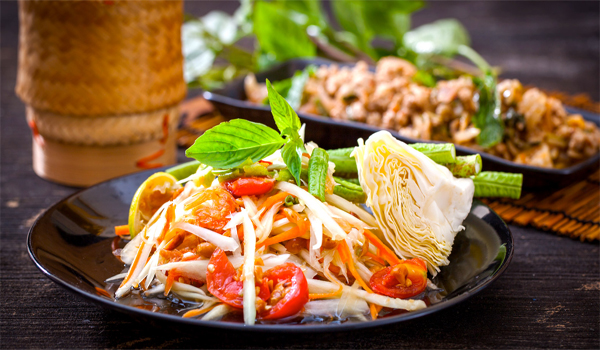It’s perhaps the number one question that Southeast Asia travelers always want to know. Unfortunately, there is no easy, cut-and-dried answer. But we can look at some average expenses in Thailand so that you can produce a more educated estimate.
Traveling in Thailand can be very affordable.
How much money you spend in Thailand obviously depends largely on what you do, how much luxury you demand, and which parts of the country you plan to visit.
Understanding Daily Expenses in Thailand
Finding the best prices and spending less in Thailand are ultimately up to you. Patronizing upscale restaurants and hotels that cater only to tourists will obviously cost more, as will doing more activities (e.g., scuba diving, taking tours, etc) and paying entrance fees to tourist places.
All jet ski rentals aside, many long-term travelers brave enough to track daily expenses in an honest fashion typically discover an ugly truth: they spent more on partying and socializing than activities, transportation, and food!
Many people tend to socialize — and ultimately drink more — while on vacation. Thailand is infamous for providing enough nightlife opportunities to send daily expenses soaring past your original estimates. Eating can be cheap and delicious, but those drinks add up.
Location Matters
Plain and simple: the islands cost more. You’ve got to pay to play in the sun. Plan to spend slightly more while in the islands on food, basics, and accommodation.
Totally worth it! Islands cost more for a reason: everything must be brought to the island from the mainland either by boat or plane. Rent for businesses is invariably more expensive near the sea, so they have to increase prices to make ends meet.
Chiang Mai and destinations in Northern Thailand such as Pai are relatively less expensive than Bangkok and the islands. If you’re on a shoestring budget, you’ll get more for your money in Chiang Mai and northern destinations in Thailand.
Location affects price down to the local level. You’ll often find better prices depending on the neighborhood in which you are staying. “Local” neighborhoods with less services for tourists are usually the cheapest.
You’ll nearly always find better prices in Thai neighborhoods farther away from tourist areas. But being a foreign visitor matters. The subject is hotly debated and controversial. Dual pricing in Thailand is common. Farang (foreigners) are often expected to pay higher prices. Tourists may be considered “rich.”
By default, the Sukhumvit area in Bangkok is the most expensive; Silom is considered pricey as well. Meanwhile, the Khao San Road and Soi Rambuttri neighborhood — once famous as a hub for backpackers — in the Banglamphu area of Bangkok can be cheaper. Although some of the old “weirdness” still exists near Khao San Road, many of the surrounding streets are now lined with chic and boutique guesthouses.
A small bottle of beer in the more expensive Silom or Sukhumvit areas of Bangkok will cost 90 – 180 baht, while you can find a large bottle in the Khao San Road area for 60 – 80 baht during happy hours or 90 baht during regular hours. Which of the top three Thai beers you choose also matters.
Unless prices are fixed (e.g., inside of minimarts) you can often negotiate for a better deal. Fair, friendly haggling is a part of Thai culture, but do it correctly. You should not try to negotiate for consumables such as water, snacks, and street food.
When You Travel Matters
Traveling during the high season in Thailand will cost a little more as people are less willing to negotiate. Hotels and guesthouses stay full enough that they don’t need to offer discounts and specials.
Traveling during the low season in Thailand (roughly June to October) may require ducking in from afternoon thunderstorms — the monsoon season keeps scenery green — but you can find more discounts.
Traveling immediately before or after major festivals and holidays in Thailand such as Songkran and Chinese New Year will cause flights and hotels to be more expensive.
Potential Expenses in Thailand
Here is a list of common expenses for your trip in Thailand along with the potential impact on your budget:
- Food: low
- Bottled water: low
- Laundry service: low
- Accommodation: medium – high
- Ground transportation: low
- Domestic flights to different regions: medium – high
- Shopping: medium
- Alcohol and socializing: high
- Tours and activities: high
- Entrance fees (foreigners often pay more than double): medium
- ATM fees (as much as 200 baht per transaction): high
- Unexpected scams: low
- Motorbike/scooter rentals: low
Accommodation in Thailand
The cost of your accommodation depends largely upon how much luxury you expect. Remember, with such an exciting country waiting outside, you’ll probably only be at the hotel to sleep!
Avoiding the large Western hotel chains and staying in local, independently owned places will nearly always save money. Cute boutique options abound throughout popular places to travel in Thailand.
Moving around frequently adds to the cost of your trip. If you intend to stay in a place for a week or longer, try negotiating for a better nightly rate. You may get a better deal — particularly during the slow season.
You’ll find backpacker guesthouses in Thailand for $10 a night (320 baht) and less, as well as five-star accommodation where the sky is the limit and staff are willing to do anything to please guests.
If your trip is short and you don’t mind spending more on accommodation, you’ll be able to enjoy much higher levels of luxury for cheaper prices than you would find in hotels at home.
Food Costs
As is often the case in Asia, eating in Thailand is relatively inexpensive — assuming you enjoy Thai food. Western food nearly always costs more than Thai food in restaurants.
 Street carts and simple, open-air restaurants will always be cheaper than eating at your hotel or in air-conditioned restaurants. Adding seafood or shrimp to traditional dishes increases the cost. The default meat served with nearly every meal is chicken; beef and pork are common options.
Street carts and simple, open-air restaurants will always be cheaper than eating at your hotel or in air-conditioned restaurants. Adding seafood or shrimp to traditional dishes increases the cost. The default meat served with nearly every meal is chicken; beef and pork are common options.
The average cost of a basic Thai meal in a restaurant is 90 – 150 baht. Seafood invariably costs more. A plate of noodles in a basic restaurant in Sukhumvit is around 100 baht. Thai portions are often smaller, so you may end up eating an extra meal or snacking during the day!
Water and Alcohol
The tap water is unsafe to drink in Thailand; hot temperatures will have you drinking far more water than you do at home.
A 1.5-liter bottle of drinking water from any of the ubiquitous 7-Eleven shops found all over Thailand costs around 15 baht (less than 50 cents). To cut down on plastic, look for free water refills in some hotels. Also, you can find water-refill machines on the street that cost only a few baht per liter.
In the islands, a fresh drinking coconut can be enjoyed for around 60 baht. A nostalgic, glass bottle of Coke costs around 15 baht.
A large bottle of Thai Chang beer can be found in restaurants around Khao San Road / Soi Rambuttri for under 90 baht. 7-Eleven price for a large bottle of beer is usually less than 60 baht. Other beers such as Singah and imports will cost at least 90 baht and up, depending on the venue.
A small bottle of Sangsom (the local Thai rum) costs around 160 baht in minimarts; there are cheaper brands (Hong Thong is one) if you’re brave enough.
Other Expenses in Thailand
A pack of Western-brand cigarettes costs 100 to 140 baht in Thailand, depending on the brand.
Outside of luxury hotels and nicer restaurants, tipping is not expected in Thailand.
Using any ATM in Thailand requires paying a steep 200-baht bank fee for each transaction.
Laundry service is very cheap in Thailand. Coin-operated laundromats can be found in the cities.
Note: All prices are in Thai baht. Your current exchange rate may affect prices, and you’ll always find exceptions for these daily living expenses in Thailand.
ALSO CHECK : 10 Top Tourist Attractions in Spain




